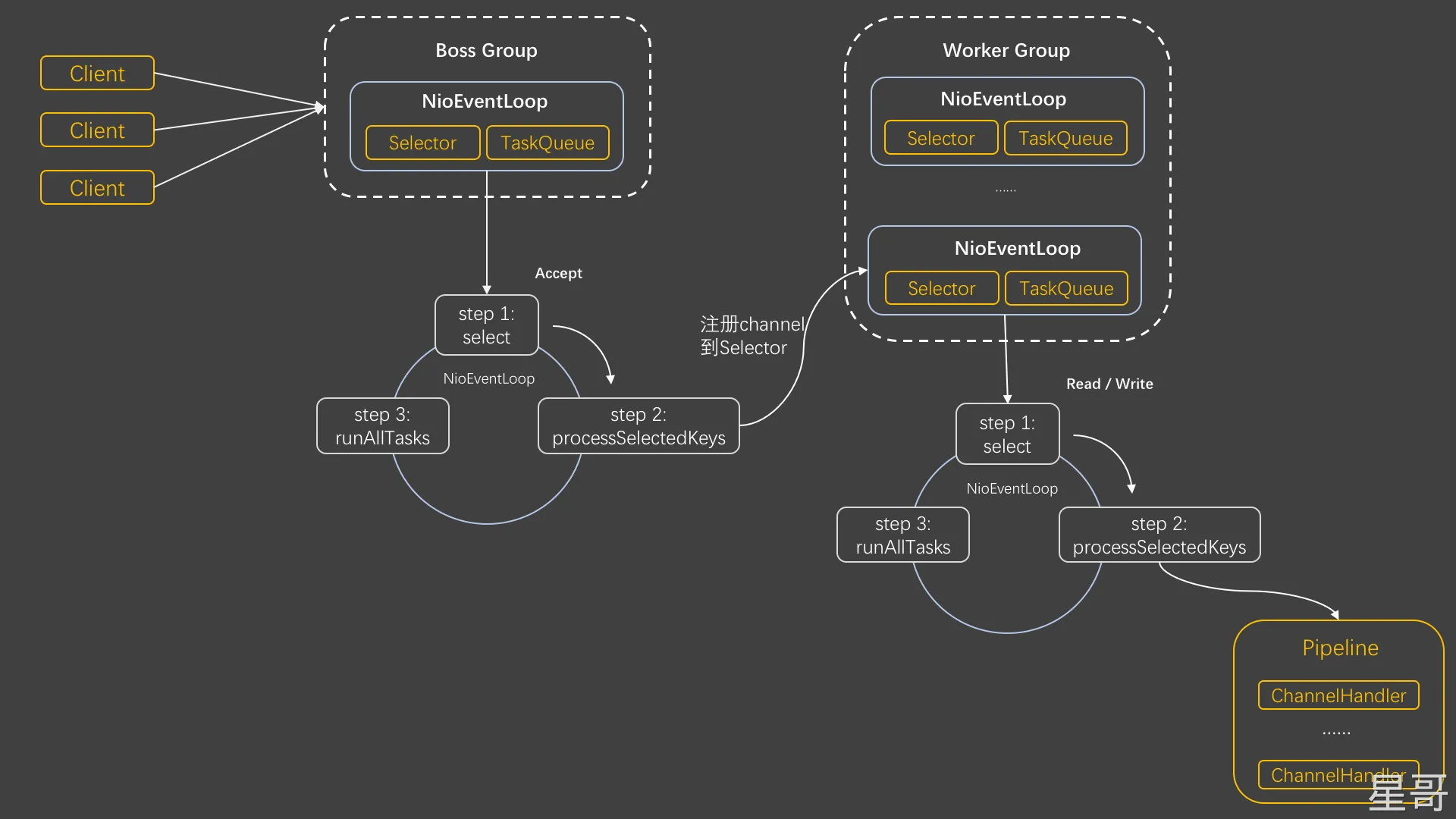Netty启动初始化分析_3
5.2 真正的绑定端口号逻辑doBind0
经过前两篇文章分析完了5.1 初始化和注册AbstractBootstrap#initAndRegister(),接着回到AbstractBootstrap.doBind(final SocketAddress localAddress)中,开始分析真正的绑定端口号逻辑
private ChannelFuture doBind(final SocketAddress localAddress) {
final ChannelFuture regFuture = initAndRegister();
final Channel channel = regFuture.channel();
if (regFuture.cause() != null) {
return regFuture;
}
if (regFuture.isDone()) {
// At this point we know that the registration was complete and successful.
ChannelPromise promise = channel.newPromise();
doBind0(regFuture, channel, localAddress, promise);
return promise;
} else {
// Registration future is almost always fulfilled already, but just in case it's not.
final PendingRegistrationPromise promise = new PendingRegistrationPromise(channel);
regFuture.addListener(new ChannelFutureListener() {
@Override
public void operationComplete(ChannelFuture future) throws Exception {
Throwable cause = future.cause();
if (cause != null) {
// Registration on the EventLoop failed so fail the ChannelPromise directly to not cause an
// IllegalStateException once we try to access the EventLoop of the Channel.
promise.setFailure(cause);
} else {
// Registration was successful, so set the correct executor to use.
// See https://github.com/netty/netty/issues/2586
promise.registered();
doBind0(regFuture, channel, localAddress, promise);
}
}
});
return promise;
}
}
进入doBind0(regFuture, channel, localAddress, promise)
AbstractBootstrap.doBind0(regFuture, channel, localAddress, promise)
private static void doBind0(
final ChannelFuture regFuture, final Channel channel,
final SocketAddress localAddress, final ChannelPromise promise) {
// This method is invoked before channelRegistered() is triggered. Give user handlers a chance to set up
// the pipeline in its channelRegistered() implementation.
channel.eventLoop().execute(new Runnable() {
@Override
public void run() {
if (regFuture.isSuccess()) {
channel.bind(localAddress, promise).addListener(ChannelFutureListener.CLOSE_ON_FAILURE);
} else {
promise.setFailure(regFuture.cause());
}
}
});
}
channel.eventLoop().execute,和之前注册的任务一样,放进队列taskQueue中。而取队列的过程在netty源码分析_2分析过,这里直接分析任务执行流程。会执行channel.bind(localAddress, promise).addListener(ChannelFutureListener.CLOSE_ON_FAILURE),先分析channel.bind(localAddress, promise)
AbstractChannel.bind(SocketAddress localAddress, ChannelPromise promise)
public ChannelFuture bind(SocketAddress localAddress, ChannelPromise promise) {
return pipeline.bind(localAddress, promise);
}
这里的链路调用很长,过程不贴出来了,最终会调用到AbstractNioChannel.doBeginRead()
AbstractNioChannel.doBeginRead()
此方法比较重要,逻辑是将之前注册到selector中的事件从不感兴趣修改为关注OP_ACCEPT事件类型
protected void doBeginRead() throws Exception {
// Channel.read() or ChannelHandlerContext.read() was called
final SelectionKey selectionKey = this.selectionKey;
if (!selectionKey.isValid()) {
return;
}
readPending = true;
//获得感兴趣的事件,由于之前在register中注册的就是0,这里得到的就是0
final int interestOps = selectionKey.interestOps();
//判断是不是对任何事件都不监听
if ((interestOps & readInterestOp) == 0) {
//将accept事件注册, readInterestOp就是OP_ACCEPT事件类型
selectionKey.interestOps(interestOps | readInterestOp);
}
}
readInterestOp就是OP_ACCEPT事件类型,赋值是在最开始的NioServerSocketChannel初始化的过程中
protected AbstractNioChannel(Channel parent, SelectableChannel ch, int readInterestOp){
/**
* 省略
*/
this.readInterestOp = readInterestOp;
/**
* 省略
*/
}
public NioServerSocketChannel(ServerSocketChannel channel) {
super(null, channel, SelectionKey.OP_ACCEPT);
config = new NioServerSocketChannelConfig(this, javaChannel().socket());
}
NioEventLoop.run()
经过doBind0后,这时终于能监听accept事件了。回到NioEventLoop.run()中
protected void run() {
int selectCnt = 0;
for (;;) {
try {
int strategy;
try {
strategy = selectStrategy.calculateStrategy(selectNowSupplier, hasTasks());
switch (strategy) {
case SelectStrategy.CONTINUE:
continue;
case SelectStrategy.BUSY_WAIT:
// fall-through to SELECT since the busy-wait is not supported with NIO
case SelectStrategy.SELECT:
long curDeadlineNanos = nextScheduledTaskDeadlineNanos();
if (curDeadlineNanos == -1L) {
curDeadlineNanos = NONE; // nothing on the calendar
}
nextWakeupNanos.set(curDeadlineNanos);
try {
if (!hasTasks()) {
//调用NIO中Selector 中的 select()或者 selectNow()
strategy = select(curDeadlineNanos);
}
} finally {
// This update is just to help block unnecessary selector wakeups
// so use of lazySet is ok (no race condition)
nextWakeupNanos.lazySet(AWAKE);
}
// fall through
default:
}
} catch (IOException e) {
// If we receive an IOException here its because the Selector is messed up. Let's rebuild
// the selector and retry. https://github.com/netty/netty/issues/8566
rebuildSelector0();
selectCnt = 0;
handleLoopException(e);
continue;
}
selectCnt++;
cancelledKeys = 0;
needsToSelectAgain = false;
final int ioRatio = this.ioRatio;
boolean ranTasks;
if (ioRatio == 100) {
try {
if (strategy > 0) {
processSelectedKeys();
}
} finally {
// Ensure we always run tasks.
ranTasks = runAllTasks();
}
} else if (strategy > 0) {
final long ioStartTime = System.nanoTime();
try {
processSelectedKeys();
} finally {
// Ensure we always run tasks.
final long ioTime = System.nanoTime() - ioStartTime;
ranTasks = runAllTasks(ioTime * (100 - ioRatio) / ioRatio);
}
} else {
ranTasks = runAllTasks(0); // This will run the minimum number of tasks
}
if (ranTasks || strategy > 0) {
if (selectCnt > MIN_PREMATURE_SELECTOR_RETURNS && logger.isDebugEnabled()) {
logger.debug("Selector.select() returned prematurely {} times in a row for Selector {}.",
selectCnt - 1, selector);
}
selectCnt = 0;
} else if (unexpectedSelectorWakeup(selectCnt)) { // Unexpected wakeup (unusual case)
selectCnt = 0;
}
} catch (CancelledKeyException e) {
// Harmless exception - log anyway
if (logger.isDebugEnabled()) {
logger.debug(CancelledKeyException.class.getSimpleName() + " raised by a Selector {} - JDK bug?",
selector, e);
}
} catch (Error e) {
throw (Error) e;
} catch (Throwable t) {
handleLoopException(t);
} finally {
// Always handle shutdown even if the loop processing threw an exception.
try {
if (isShuttingDown()) {
closeAll();
if (confirmShutdown()) {
return;
}
}
} catch (Error e) {
throw (Error) e;
} catch (Throwable t) {
handleLoopException(t);
}
}
}
}
这时队列tailTasks的任务为空,strategy = selectStrategy.calculateStrategy(selectNowSupplier, hasTasks())的结果为-1,可以执行strategy = select(curDeadlineNanos)
NioEventLoop.select(long deadlineNanos)
调用NIO的Selector 中的 select()或者 selectNow(),返回注册到当前Selector中的,发生关注的IO事件的Channel个数
private int select(long deadlineNanos) throws IOException {
if (deadlineNanos == NONE) {
//会执行到这里,关注accept事件,没有此事件则会一直阻塞
return selector.select();
}
// Timeout will only be 0 if deadline is within 5 microsecs
long timeoutMillis = deadlineToDelayNanos(deadlineNanos + 995000L) / 1000000L;
return timeoutMillis <= 0 ? selector.selectNow() : selector.select(timeoutMillis);
}
总结
select轮训注册在其中的 Selector 上的 Channel 的 IO 事件processSelectedKeys在对应的 Channel 上处理 IO 事件runAllTasks以此循环处理任务队列中的任务
至此完成了流程图中Boss Group中的部分
